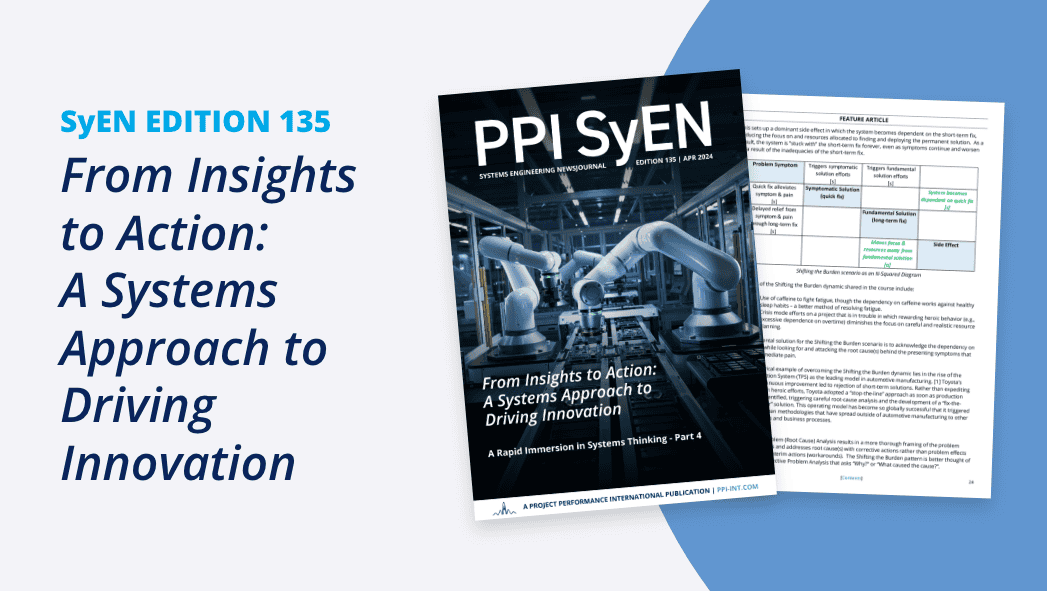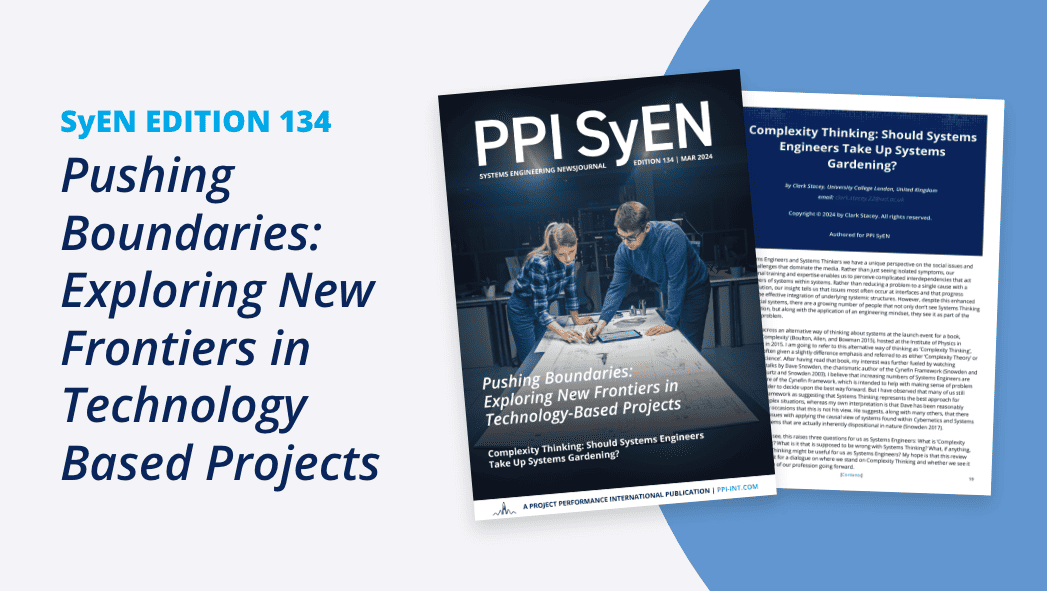WHAT’S INSIDE:
Quotations to Open On
Read More… (link/anchor to Quote)
Feature Article: The Lifecycle Modeling Language – A new functional language for systems engineering applications across the product lifecycle
Read More…(link/anchor to article)
Systems Engineering News
INCOSE Renews Call for Participation in the NDIA/IEEE/SEI Systems Engineering Effectiveness Study
The 3rd TUM Spring School on Systems Engineering (TUMS3E)
Call for Nominations – 2012 User Centered Product Design Award
International Journal of Education Research (IJER) Call for Papers
LAI Researchers Receive 2011 INCOSE Working Group Award for Collaboration
Workshop on Systems Thinking for Solving Complex Problems
Formation of INCOSE Chapter in Brazil
Read More…(link/anchor to News)
Featured Societies – The Association of Business Process Management Professionals International (ABPMP International)
Read More…(link/anchor to Societies section)
INCOSE Technical Operations: In-Service Systems Working Group
Read More…(link/anchor to INCOSE Tech…section)
Systems Engineering Tools News
JIRA
Pivotal Tracker
Cradle – RM/SE Tool from 3SL – Version 6.6
6D Project Catalyst Desktop
Relatics
Read More…(link/anchor to SE Tools section)
Systems Engineering Books, Reports, Articles, and Papers
Engineering a Safer World: Systems Thinking Applied to Safety
The International Journal of the Analytic Hierarchy Process
How to Save a Failing Project: Chaos to Control
BA Connection Newsletter February 2012
Read More…(link/anchor to SE Books, Articles…)
Conferences and Meetings
Read More…(link/anchor to Conferences section)
Education and Academia
Help for Individuals Selecting Engineering Schools and Programs
NASA Graduate Certificate in Space System Engineering
Research Fellow and Post-doctorate Positions Available, Financial Services Governance Risk and Compliances Competence Centre (GRC3), University College Cork, Ireland
Position Available at INRIA Sophia Antipolis, France
New Student Group Opens Doors to Careers in Systems Engineering
Read More…(link/anchor to Edu/Academia section)
Some Systems Engineering-Relevant Websites
Read More… (link/anchor to Websites)
Standards and Guides
- EN 50126 / IEC 62278 Railway RAMS Standard
Read More…(link to Standards & Guides section)
A Definition to Close on – Unified Processes
Read More…(link/anchor to Definition)
PPI News
Read More…(link/anchor to PPI News)
PPI Events
Read More…(link/anchor to PPI Events)
Quotations to Open On
“Plans are only good intentions unless they immediately transition into hard work.”
– Peter Drucker (1909-2005)
“To the optimist, the glass is half full. To the pessimist, the glass is half-empty. To the systems engineer, the glass is twice as big as it needs to be”
– Unknown.
Feature Article
The Lifecycle Modeling Language
A new, functional language for systems engineering applications across the product lifecycle
Steven H. Dam, PhD
Copyright All rights reserved
Licensed under Creative Commons Attribution
(www.creativecommons.org).
The purpose of this paper is to describe the features of the Lifecycle Modeling Language (LML) that provides a simpler, more effective means to design, operate and maintain large, complex systems.
So Why Do We Need LML?
Many in the systems engineering community have espoused the need for Model-Based Systems Engineering (MBSE), where information describing the system design is captured in a model, from which the documentation can be produced. For some, they have advocated the use of the Systems Modeling Language (SysML), which is a profile of the Unified Modeling Language (UML) developed for software engineering. The logic of using SysML mostly comes from the idea that most systems today are software-intensive and that software is “the problem.” By it being “the problem,” we mean software is difficult to develop, validate, and have complete confidence in its ability to meet all the potential uses of a system. This problem will be exacerbated by the advent of cloud computing, which has the potential to scale databases to very large sizes, hence enabling us to capture the complete design to the part level, test and evaluation data, operational procedures, and all the other aspects that describe the system throughout the lifecycle. SysML is meant to enable systems engineers to better communicate with the software developers and hence improve the implementation of the system requirements into the software.
However, no other discipline uses to any great extent the underlying object-oriented approach that SysML models. Also, SysML is diagram focused, thus leaving the underlying data schema elements needed to describe a system up to the implementers of SysML (i.e. the tool vendors).
The user community in particular seems to have little or no interest in these abstract diagrams, which represent people as stick figures.
We also discovered that the software development community has moved on to “Agile Programming” techniques, which require functional requirements, not objects.
So the bottom-line is that SysML does not meet the needs of most of the user and developer communities, so systems engineers, whose primary job is to facilitate communication between users and the other disciplines, do not have a language that most find understandable, let alone useful.
Therefore, we explored other approaches and languages that might reduce complexity, while being more useful to all the stakeholders in the lifecycle. The result was LML.
Lifecycle Modeling Language (LML)
LML provides a functional language that captures the minimum set of information needed to describe the system fully. Clearly, “minimum” and “fully” form a difficult set of criteria and thus required a significant amount of effort to balance the two. It also needs to describe not only the technical elements of the systems, but also program management aspects as well; otherwise the systems engineer cannot perform the optimization of cost, schedule and performance.
As such, we analyzed a number of different schemas and used our experience in systems engineering to form the following taxonomy:
Technical Elements:
- Action
- Artifact
- Asset (Resource subclass)
- Characteristic
- Input/Output
- Link
- Statement(Requirements subclass)
Program Management Elements:
- Cost
- Decision
- Location (Physical, Orbital, Virtual subclasses)
- Risk
- Time
These elements represent the essential elements of information needed to describe the systems and the program that builds the system. For example, the Action class can be used for functions, activities or tasks. So we can capture information on how the system operates (functions), what the operators do (activities), and the steps necessary to design and build the system (tasks). We can distinguish between these different types of actions using the “Type” attribute. This attribute contains a list of these aliases to enable us to easily separate them in diagrams and reports. Having the different types of attributes in the same “bin” enables us to reduce the potential for duplication of the same information in different classes. Sorting a list of Actions by name quickly helps us identify potential duplicates.
Several of the elements have subclasses (e.g., Requirement is a subclass of Statement). These subclasses have additional attributes, which are not needed by the parent class. In the case of Requirements, we have included attributes that describe the quality of the requirement (clear, complete, correct, consistent, feasible, modular, design, and verifiable).
In the Program Management elements, in addition to cost and schedule (Time), we explicitly capture Decisions and Risks, thus enabling them to be linked to other technical elements. Hence, we can trace the decision path for choosing particular design solutions, including the “who” and “when” a decision was made, as well as the “why.” Note also the Location element. Since many factors depend on where something is located, we included that element, along with the three subclasses. We have found that few schemas consider all three of these possibilities and they each clearly have very different attributes to fully describe them. Now with the combination of time and space, we can also add the full dynamics of the design, along with operations and support.
Connecting these elements, we establish relationships between them in both directions to enable full traceability between each of these elements. Figure 1 shows a summary of the elements and their relationships. Each relationship has a defined inverse to enable traceability from the top-down and the bottom-up. We also made sure all relationships and their inverses had the same verb. So an Action element is performed by an Asset and the Asset performs the Action. At times, a better inverse verb might have been chosen, but we decided to use the same verb in each case to avoid confusion.
Similarly, we made all the parent-child relationships to be decomposed by/decomposes. Again, these may not be the best word choices in every instance, but avoiding complexity and confusion was our primary objective. Having used other schemas that did not do this caused significant problems over the years.
We also allow/enable attributes on the relationships, such as Amount on the captures relationship used between Actions and Resources. We used this feature in a very limited way. Of course, the users of LML can extend the schema as needed to accommodate special circumstances.
Figure 1. LML relationships provide traceability between all the classes.
Note that only a few combinations of elements have no relationships (e.g., Action/Link). These few instances are due to the separation of functional and physical information. In all other cases, we see relationships between the classes as an important part of overall design traceability.
This schema has a number of benefits. First, as stated above, reducing the number of primary data elements means less complexity for analysts to deal with, thus enabling quicker capture and presentation of the information for analysis and decision making.
Another benefit comes from including programmatic, as well as technical, elements of information in this base schema, such as cost and schedule.
A third benefit comes from eliminating the overlap between similar data elements (requirements, constraints, performance criteria, etc.), which are all just textual Statements. Making Requirements a subclass of Statements instead reduces the potential for duplication of information which cuts the time and cost of data gathering. As a result of these three benefits, a more cost-effective way of describing an architecture or system design can be provided.
LML Describes Behavior
Many modeling techniques, such as IDEF 3, and UML Activity Diagram, capture functional sequencing using a variety of constructs to represent logic. They use symbols such as a diamond or plus sign to indicate decisions or AND logical elements.
As we explored these and other types of logic diagrams, including electrical engineering diagrams, we realized that something very important was missing. The constructs only showed up on the diagrams, but never as part of the function list. Hence, the critical decision functionality was not being captured explicitly as a function! Since those functions include command and control functionality, as well as how we perform information assurance, we changed the way everyone else captured that information. As a result, Figure 2 shows the LML simplified logic.

Figure 2. LML’s simplified logic captures the functionality of all decision points.
Actions are represented by rectangles. A special case of the Action is a decision point, indicated by a diamond superimposed on the rectangle. The decision points come in three varieties: OR, AND, and LOOP. The OR represents the logic of two paths you might go down, choosing one path or the other. The AND indicates two paths that can proceed independently and must be synchronized before continuing. Finally, the LOOP identifies Actions that repeat until the exit criterion has been achieved. Note also the dashed lines on the OR and LOOP. These indicate that the paths are optional depending on the decision point criteria.
These logical elements can be combined to create a process flow or functional sequence. Figure 3 shows an example of such a logical flow. It also includes a new symbol to represent the data flow between actions. Using parallelograms for the data (Input/Output) elements (from the old standard flow chart symbols), we use curved lines to connect them to the Action elements to avoid confusion between the functional sequencing lines and the data flow lines. You may remember these from the old Yourdon-DeMarco Data Flow Diagrams (DFD). A special case of the Input/Output element is also shown in green. These trigger elements limit the Actions from proceeding until that piece of information is received.
By combining these older, recognizable symbols with the decision points, the result is an approach that many people should find easier to understand; it looks like a useful drawing, and the diagram has semantic meaning. Hence, we can simulate the process flow and see how it executes, thus validating the logic and determining the timing of the sequence. Thus, we can input this diagram information into a discrete event simulator and show how it works (or doesn’t work) since it is straight-forward to design logic with bottlenecks or failure modes).
Other diagrams, such as a Physical Diagram, are currently being defined. A complete draft LML specification is under development and should be available in the second quarter of 2012. It will enable tool builders to implement LML. We will be very interested in community feedback on the language and associated diagrams.

Figure 3. The LML Action Diagram captures functional behavior.
Tool Requirements
Different people are comfortable with different tools for a variety of reasons. We have formed preferences over the last 20 years of using these kinds of tools to do system engineering and architecture development. Having used a number of these tools over the years we found that many lacked the ability to do much more than draw a picture (and sometimes it wasn’t even a pretty picture). Some have a database, but limited or no report writing capability. Most do not have any way to simulate the diagrams they draw, so you can not verify the logic. Many also have no way of extending the schema; even if they let you see the schema (most hide that from the user). The most popular tool has no schema whatsoever, so one has to spend a significant amount of time developing the schema first.
LML can provide a schema for you to collect the information. You can use drawing tools, such as MS PowerPoint or Visio to draw the diagrams, but these will not help you verify the logic through execution. As such, the LML tool will need to be developed to fully implement the new ideas and capabilities LML offers. We are aware of at least one tool under development that should be available later this year (2012). Ideally any tool would take advantage of cloud computing capabilities for creating large scale models and simulations, as well as potentially worldwide collaboration. The ability to translate to and from LML with other languages would be welcome.
We hope to see a number of the tool vendors add LML to their list of capabilities in the future.
LML: The Way to Reducing Complexity
LML was developed as a result of over 18 years of performing system engineering and architecture development using portions of the technique. The latest twist to the technique comes from the new schema.
Some of the cost-effective features of LML include:
• Simplification of MBSE techniques developed over the past 30 years
• Application across the entire product lifecycle (concept to disposal)
• Inclusion of both technical and program management elements to enable the optimization of cost, schedule and performance
• Capture of functional sequencing (as explicit decision points) to enhance the modeling of command and control, as well as information assurance functions.
We also recognize that LML is only the “80%” solution. Users will want to modify it for particular uses, but LML should provide a good starting point for any design, development, operations, or support activity.
Please send any suggestions, comments, or questions on the language or diagrams to our website www.specinnovations.com.
Systems Engineering News
INCOSE Renews Call for Participation in the NDIA/IEEE/SEI Systems Engineering Effectiveness Study
In 2006, the SE Effectiveness Committee of the NDIA Systems Engineering Division conducted the Systems Engineering Effectiveness Study (SEES). Using survey techniques, this study identified statistical relationships between the application of specific SE practices to development projects and the performance of those projects, as measured by satisfaction of budget, schedule, and requirements. The results, published in 2007 and 2008, clearly demonstrated the benefits of SE, showing that:
• In the set of projects applying the least SE, only 15% delivered the highest levels of performance;
• In the set of projects applying the most SE, 56% delivered the highest levels of performance.
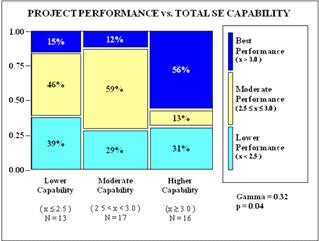
The study also identified relationships between specific SE practices (e.g., requirements development, trade study performance, architecture development) and project performance. For more information about the SEES, you may download several reports, papers, and presentations from the BCSE web site: http://www.sei.cmu.edu/go/bcse2/.
Based on the success of the prior study, in 2010 the NDIA embarked on the BCSE project to update and enhance it by gathering data from a larger and more diverse population. This study will survey individual product-producing projects to assess: 1) the characteristics of the project, 2) the SE activities applied to the project, and 3) the resulting project performance. Completion of the survey will require approximately 30 minutes for each project. Like the prior survey, data security and confidentiality will be paramount. ALL DATA WILL BE COLLECTED ANONYMOUSLY. No information identifying the project, organization, or respondent will be requested. The Software Engineering Institute will do the data collection and analysis. Only they will see responses, and only statistical summaries of the aggregated data, untraceable to any project, organization, or person, will be released.
Similar to the original study, those who participate will be rewarded with early access to more detailed levels of aggregated data and analysis for one year prior to these results being published for everyone. This will allow participants to assess their organization/project results relative to the rest on the industry, showing strengths and areas of weaknesses that should be addressed.
To participate, contact Joan E. Nolan, INCOSE SE Effectiveness Working Group, on +1 410 765-9423, or by email: joan.nolan@incose.org
The 3rd TUM Spring School on Systems Engineering (TUMS3E)
The third “TUM Spring School on Systems Engineering” will take place in Munich, Germany, over 26 – 30 March 2012. The event will be held in cooperation with the Stevens Institute of Technology. The spring school relates to PhD students of all disciplines whose working areas are related to any aspect of systems engineering. The aim of the four day course is to encourage international scientific exchange on important literature, definitions, and actual and future topics. Furthermore, the PhD students should gain an insight into industrial implementation and application of systems engineering. Besides general talks on systems engineering, the participants in the course will present their own topics, and there will be intense discussions with invited guests from academia and industry. Guests will also present current requirements for systems engineering and challenges in their companies.
More information http://www.tums3e.org/
Call for Nominations – 2012 User Centered Product Design Award
The Product Design Technical Group (PDTG) of the Human Factors and Ergonomics Society (HFES) welcomes submissions for its 11th Annual Stanley Caplan User-Centered Product Design Award. The award emphasizes innovative and user-centered approaches to HF/E and industrial design. For the past 10 years, the PDTG has recognized outstanding product design and the methods used to specify and achieve that design, and we invite you to help us celebrate our 11th anniversary. This year’s winning product or system will be recognized during the HFES 2012 Annual Meeting at the Westin Boston Waterfront in Boston, Massachusetts. The winner will receive a $1,000 honorarium and make a presentation on the product and the development methodology during the PDTG’s award session. Submissions may address products, software, or systems that are purchased for use in the home, in the workplace, or while mobile. They may include consumer, commercial, and medical products but exclude military equipment and systems. The product or system being nominated must be operational and capable of being marketed with no more than minimal changes. Products already on the market for more than three years will not be considered. Past winners have been highly diverse in terms of types of products and have spanned the technology spectrum from low to high.
More Information http://tg.hfes.org/pdtg
International Journal of Education Research (IJER) Call for Papers
The International Journal of Education Research (IJER) is currently accepting manuscripts for publication. IJER publishes, monthly, high-quality solicited and unsolicited articles, in English in all areas pertaining to education and educational administration, psychology and counseling, policy studies, technical education, vocational studies, English and literature, physical education. The journal also encourages education researchers to join its editorial and reviewers teams. The International Journal of Education Research provides free access to all articles as soon as they are published.
More information www.onlineresearchjournals.org
LAI Researchers Receive 2011 INCOSE Working Group Award for Collaboration
LAI researchers Drs. Josef Oehmen and Bob Kenley have received the 2011 INCOSE Working Group Award for Collaboration with the Lean Systems Engineering Working Group. The award recognizes the group’s collaborative work with PMI, LAI, and INCOSE Corporate Advisory Board (CAB) companies to bridge the gap between program management and systems engineering. The award was presented during the Opening Plenary at the 2012 INCOSE International Workshop on Saturday, January 21, in Jacksonville, Florida.
More Information http://cse.lmu.edu/about/graduateeducation/systemsengineering/INCOSE.htm
Workshop on Systems Thinking for Solving Complex Problems
Systems Thinking is a scientific approach to problem solving that deals with hidden complexity and sustainability. It:
· Provides tools and techniques for solving complex problems.
· Improves understanding and anticipation of long term consequences of decisions, actions, policies and strategies.
· Aims to avoid unintended consequences.
This workshop will introduce ‘systems thinking’ as a tool for helping central and local government work better together and address complex problems. Led by Professor Kambiz Maani, an internationally renowned expert in systems thinking and sustainable strategies, participants will learn how to use systems thinking as a tool for multi-dimensional, multi-stakeholder decision making at local and national levels.
More information http://www.solgm.org.nz/tools/events/details.aspx?SECT=Business_School_Events&ID=279
Formation of INCOSE Chapter in Brazil
Planejamos nos reunir em Assembléia Geral, no LIT do INPE, São José dos Campos, na segunda feira 19 de março de 2012, à tarde, para aprovarmos a versão final do estatuto e confirmarmos a escolha dos membros da diretoria e conselhos do INCOSE Brasil. Brasileros, reservem essa data em suas agendas.
A meeting is planned at LIT of INPE, São José dos Campos, Brasil, on the afternoon of Monday, 19th March, to approve the final version of the proposed bylaws of INCOSE Brasil and to appoint office holders. Brazilian engineers, reserve this date in your diary!
INCOSE News – New Chapters
INCOSE members and volunteers in Eastern Washington & Oregon USA have re-established a regional network of professionals interested in systems engineering. These efforts have progressed to the point of accreditation of the Cascade INCOSE Chapter in the area.
INCOSE Switzerland is also newly accredited as a Chapter, with the primary goal of offering events and resources on anything Systems Engineering for the Swiss community. An organizational meeting took place in September 2011 at RUAG Space in Zurich. See http://incose.ch/home/ for more information.
We wish both chapters every success in advancing systems engineering practice.
Featured Society
The Association of Business Process Management Professionals International (ABPMP International)
The Association of Business Process Management Professionals International is a non-profit, vendor-independent, professional organization dedicated to the advancement of business process management concepts and practices. ABPMP International is practitioner-oriented and practitioner-led. The mission of ABPMP International is:
• To engage in activities that advance the practice of business process management,
• To promote and evolve a Common Body of Knowledge in this field,
• To foster the development and advancement of the skills and competencies of the professionals who work in this discipline,
• To validate the professional qualifications and certify BPM practitioners.
ABPMP International considers Business Process Management (BPM) to be both a management discipline and a set of technologies that support managing by process. According to the ABPMP International’s Guide to The BPM CBOK®, “Business Process Management (BPM) is a disciplined approach to identify, design, execute, document, measure, monitor, and control both automated and non-automated business processes to achieve consistent, targeted results aligned with an organization’s strategic goals. BPM involves the deliberate, collaborative and increasingly technology-aided definition, improvement, innovation, and management of end-to-end business processes that drive business results, create value, and enable an organization to meet its business objectives with more agility. BPM enables an enterprise to align its business processes to its business strategy, leading to effective overall company performance through improvements of specific work activities either within a specific department, across the enterprise, or between organizations.”
ABPMP International’s CBPP® is a certification that has been developed by and for BPM practitioners. It is said to be the first independent, professional examination and certification program in the area of BPM. CBPP® has been designed to comply with international certification standards, with the goal of becoming the internationally recognized standard for BPM professionals.
ABPMP International has local chapters in all regions of the United States and in Brazil, with many more forming in the United States and elsewhere – Argentina, Chile, Columbia, Mexico, Norway, and Pakistan. The organization is affiliated with BPM organizations in Austria, France, Germany, and Switzerland. ABPMP International is governed by an elected Board of Directors. Each chapter president is an ex-officio and voting member of the International Board of Directors. ABPMP International has a Board of Advisors made up of well-known authors, practitioners, and thought-leaders in the field. They are also volunteers, and periodically offer the Board of Directors and chapters advice on the industry and how ABPMP can best serve its members.
Grades of membership are from Student, through Associate/Academic/Affiliates, Corporate, to Professional. All grades require formal commitment to a code of ethics.
More information http://www.abpmp.org
INCOSE Technical Operations
In-Service Systems Working Group
http://www.incose.org/practice/techactivities/wg/iss/
Charter
The Charter of the In-Service Systems Working Group (ISSWG) is to provide improved advice on:
- The difficulties encountered in practice in applying authoritative guidance on SE, including the INCOSE SE Handbook, to systems which are in service. The Group should restrict itself to difficulties which are related to the fact that the systems are in the in service phase of the lifecycle.
- Best current practice in adapting SE guidance to overcome these difficulties
The success criteria for the working group should be that their recommendations are generally supported by the SE community and capable of being put into practice.
Leadership
- Chair: Marcel van de Ven, Kroon
- Deputy Chairs: Jon Hulse, Delcan; Joe Talik, Verizon
Members: 24
Accomplishments / Products
(May 2011) Delivery of report on applying SE to in-service systems. This contains guidance on In-service SE in four areas: Requirements, Validation and Verification; Architectural Design; Implementation and Transition; and Information and Configuration Management. It also contains for recommendations for integrating this guidance with other SE guidance and for promulgating the guidance.
Current Projects
The group is currently liaising with others within INCOSE to take forward the recommendations above.
Systems Engineering Tools News
JIRA
This low cost product has been used for requirements management in small agile projects, sometimes integrated with Confluence (an editor which can integrate JIRA with MS Office).
More information http://www.atlassian.com/software/jira/overview
Pivotal Tracker
Pivotal Tracker includes basic requirements management functionality intended for use in an agile development environment.
More information http://www.pivotaltracker.com
Cradle – RM/SE Tool from 3SL – Version 6.6
SE Tools Company 3SL is on track to release a new version of its requirements management/systems engineering tool Cradle, version 6.6, on schedule. A Beta copy is available to Cradle users for feedback over a very limited time.
More information: contact Mark Walker by email at mark.walker@threesl.com
Relatics
PKM Solutions’ product Relatics is a generic web-based information management application which aims to support projects and processes in a flexible and intuitive way. To use Relatics for Systems Engineering purposes, PKM Solutions has build, in corporation with its partners, a Systems Engineering template. This template covers elements like building/construction parts, design requirements, documents in relation to process related objects like organizations, verifications, inspections and responsibilities.
More information https://www.relatics.com/site?
6D Project Catalyst Desktop
6D Project Catalyst Desktop by 6D Tech Inc. allows the engineering manager to build a reusable WBS Dictionary and save methodologies inside Microsoft Project Standard or Professional. Project Catalyst allows the user to build a Process Asset Library – author, assemble, deploy and improve the organization’s practices inside Microsoft Project. Project Catalyst’s knowledge base is said to have a flexible design to support all projects within an organization, based on any process standard (e.g. CMMI, PMI PMBOK® Guide, ISO, or PRINCE2). Additional capabilities include:
• Definition of roles and responsibilities;
• Attachment of reference and deliverable documents, including examples, templates and project deliverables; and
• Capture of lessons learned.
More information http://www.6dtech.com/Products/6DProjectCatalystDesktop.aspx
Systems Engineering Books, Reports, Articles and Papers
Engineering a Safer World: Systems Thinking Applied to Safety
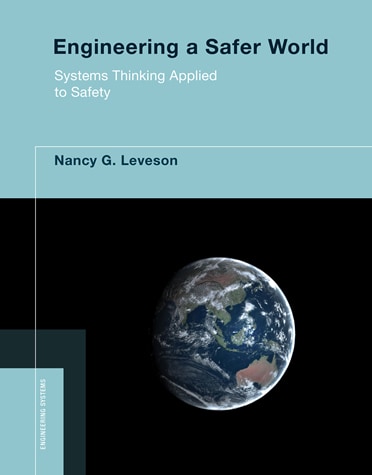
Published by: MIT Press http://mitpress.mit.edu/catalog/item/default.asp?ttype=2&tid=12662
ISBN-10:0-262-01662-1; ISBN-13:978-0-262-01662-9
Publication Date: December 2011
Binding(s): Cloth
Abstract: The book takes a new, systems approach to safety that is suited to today’s complex, sociotechnical, software-intensive world. Leveson uses an extended model of causation (Systems-Theoretic Accident Model and Processes, or STAMP), then shows how the new model can be used to create techniques for system safety engineering — including accident analysis, hazard analysis, system design, safety in operations and management of safety-critical systems. She applies these techniques to real events, such as the friendly-fire loss of a U.S. Blackhawk helicopter in the first Gulf War; the Vioxx recall; the U.S. Navy SUBSAFE program; and the bacterial contamination of a public water supply in a Canadian town.
More Information (embed hyperlink)
Basiswissen Requirements Engineering
Klaus Pohl, Chris Rup
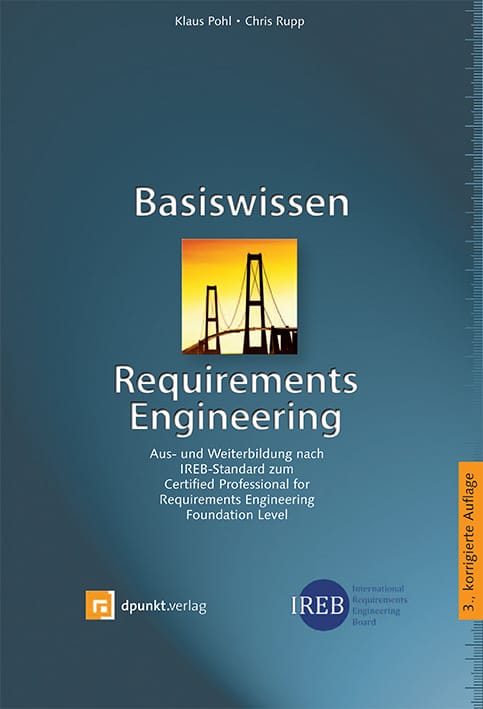
Published by: Dpunkt Verlag
http://www.dpunkt.de/buecher/3732/basiswissen-requirements-engineering.html
ISBN 978-3898647717
Publication Date: June 2011
DescriptionThis textbook – the only one of its kind – was written by the coauthors of the IREB syllabus Chris Rupp and Dr. Klaus Pohl with further supported granted by other IREB-members. It is designed to detail and illustrate all the topics covered in the syllabus version 2.0.
This book enables you to autonomously prepare for the certification exams, but it may also be used as a supplement to training courses offered by certified providers.
The book encompasses all relevant topics which make up requirements engineering: Elicitation of Testing, Documenting and managing requirements
The changes implemented with the 2.0 version of the syllabus have all been accounted for.
It will enable you to perfectly prepare for the certification, to make sure you’ll soon be a certified requirements engineer.
The International Journal of the Analytic Hierarchy Process
The International Journal of the Analytic Hierarchy Process has published its latest issue. The publishers invite you to review the Table of Contents at http://www.ijahp.org/index.php/IJAHP and then visit their web site http://www.ijahp.org/index.php/IJAHP/issue/current to review articles and items of interest.
The International Journal of the Analytic Hierarchy Process (IJAHP) is an electronic journal about multi-criteria decision making using the AHP, published by the Creative Decisions Foundation (CDF).
How to Save a Failing Project: Chaos to Control
Ralph R. Young, CSEP; Steven M. Brady, PMP; and Dennis C. Nagle, Jr.

From a review on Amazon.com: “This is, simply put, an outstanding resource for any project manager, whether your project is going well or failing. It’s written in plain English, is a fast read, and is loaded with valuable information. I would recommend that this book be read before starting any project to put in place the mechanisms and processes to prevent the chaos from developing. My favorite aspect of the book is the notes and references. The authors have loaded this book with numerous references – hard copy and on the web – and I can’t wait to go back through the book a second time just to begin following up on those. I will be using this text with my project managers as well as my offshore team to reinvigorate the process-based approach and the fact-based management techniques. I strongly recommend this book to all project and program managers.” Clifford B. Vaught, Glen Allen, VA United States
More Information http://www.amazon.com/How-Save-Failing-Project-Control/dp/1567262392/ref=ntt_at_ep_dpi_4
BA Connection Newsletter February 2012
The February 2012 edition of BA Connection, newsletter of the International Institute of Business Analysis (IIBA), includes the following articles:
- Empowering Business Analysts
- 7 Steps to Choosing a Vendor Tool
- New Academic Diploma in Business Analysis
- Registration is Now Open for BBC 2012!
- The Role of Educators in the Community of Practice
- A Global Community of Business Analysts
- Creating Bulletproof Business Cases Part 4: Cost-Benefit Analysis
- The Requirements of Connected Requirements, Estimates, and Work Plans
- Modeling for Business Analysts Part 8: The Tale of Two Constructs
- Benefits of CCBA and CBAP Certification – We want to hear from YOU!
- Post your Feedback on the Agile Extension to the BABOK Guide – Deadline Extended to February 29
Requirements Engineering Fundamentals
Klaus Pohl, Chris Rupp
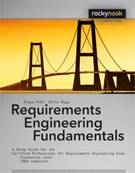
Published by: Rocky Nook Inc.
http://www.rockynook.com/book/210/requirements-engineering-fundamentals.html
ISBN-13: 978-1933952819
Publication Date: April 2011
Paperback
Description: The ideal preparation book for the certification exam “Certified Professional for Requirements Engineering” of the IREB. Conform to the IREB CPRE Foundation Level Syllabus 2.1 On the one hand you can use this book for self-study to train specifically for the certification exam. On the other hand it can be used as a supplement for one of the exam preparation courses offered by training providers. The first edition of the English book covers the entire basic knowledge necessary for the exam of the English syllabus for CPRE Foundation Level (version 2.1). In practice, requirements engineering tasks become more and more complex. In order to ensure a high level of knowledge and training, the International Requirements Engineering Board (IREB) worked out the training concept “Certified Professional for Requirements Engineering” which defines a requirements engineer’s practical skills on different training levels. The book covers the different subjects of the curriculum for the “Certified Professional for Requirements Engineering” (CPRE) defined by the International Requirements Engineering Board (IREB). It supports its readers in preparing for the test to achieve the “Foundation Level” of the CPRE.
Requirements – Engineering und – Management
Chris Rupp, die SOPHISTen
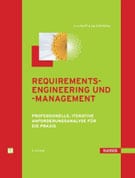
Published by: Hanser Fachbuchverlag
http://www.hanser.de/buch.asp?isbn=978-3-446-41841-7&area=Computer
ISBN-13:978-3-446-41841-7
Publication date: 2009
Abstract: This mini-tutorial will provide high-level guidance on designing a requirements management solution and selecting a requirements management tool. The guidance will focus on first understanding the context, stakeholders and tasks, so on articulating the problems that need to be addressed and the constraints that shape viable options. The guidance will also attend to the equally critical issue of managing the high expectations that are typically associated with requirements management tool adoption and use. Through examining the minimum and desirable requirements, based upon the type and size of project, the question of whether a requirements management tool is needed at all can also be considered.
UML 2 glasklar
Chris Rupp, Stefan Queins, Barbara Zengler
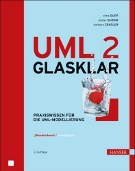
Published by: Hanser Fachbuchverlag
http://www.hanser.de/buch.asp?isbn=978-3-446-41118-0&area=Computer
ISBN-13:978-3-446-41841-7
Publication Date: 2007
Flexcover Edition
Description: The following questions are inter alia answered:
What are the charts there in UML 2? Which elements are the charts? What should I look at the modeling with a particular chart? For Updater: What has changed since the UML 1.x? How can I customize the UML to my project needs? As the most important diagrams in the program code can be represented? What I really need from the UML?
Requirements Engineering Grundlagen, Prinzipien und Techniken
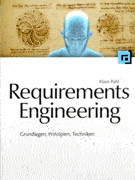 Klaus Pohl
Klaus Pohl
Published By: Dpunkt.Verlag GmbH
http://www.dpunkt.de/buecher/3014.html
ISBN-13:978-3540211785
Publication date: 2007
Description: The book provides a comprehensive introduction to the fundamentals, principles and techniques of requirements engineering. The compact representation of the content and structuring a framework by making it both a reference book for practice, teaching and research.
From the contents:
* From analysis of the system for continuous requirements engineering
* A framework for requirements engineering
* Techniques for the documentation, collection and compliance requirements
* Techniques for validating and managing requirements
* Techniques for identifying sources of requirements and context analysis
* The use of targets, scenarios and their interactions
* Traditional requirements models: Daten-/Struktur, function and behavior
* The goal-and scenario-based requirements engineering method COSMOD RE
* Requirements-based testing, requirements engineering in CMMI and in the product line development
Numerous examples, checklists and guidance on the practical application of the techniques and annotated recommended reading complete this textbook.
More About Software Requirements: Thorny Issues and Practical Advice
Karl E. Wiegers
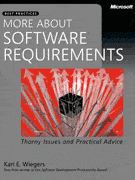
Published by: Microsoft Press
http://www.microsoft.com/learning/en/us/book.aspx?ID=9347&locale=en-us
ISBN-13:978-0735622678
Publication date: 2005
About The Book: Your up-to-date, practical guide to the real-world software requirements engineering process
No matter how much instruction you’ve had on managing software requirements, there’s no substitute for experience. Too often, lessons about requirements engineering processes lack the no-nonsense guidance that supports real-world solutions. Complementing the best practices presented in his book, Software Requirements, Second Edition, requirements engineering authority Karl Wiegers tackles even more of the real issues head-on in this book.
With straightforward, professional advice and practical solutions based on actual project experiences, this book answers many of the tough questions raised by industry professionals. From strategies for estimating and working with customers to the nuts and bolts of documenting requirements, this essential companion gives developers, analysts, and managers the cosmic truths that apply to virtually every software development project
Optimieren von Requirements Management & Engineering: Mit dem HOOD Capability Model
Colin Hood, Rupert Wiebel
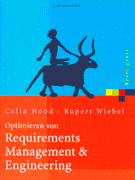
Published by: Springer
http://www.springer.com/computer/swe/book/978-3-540-21178-5
ISBN-13:978-3540211785
Publication date: 2007
Paperback
Description: Reduced budgets, tougher competition, increasingly complex products and ever shorter product cycles require improved measures when collecting and further processing of requests. Efficient capture and organize requirements is always more than one of the most cost-effective way known to increase the performance of an organization. Structuring of requirements improves the quality of the finished system and reduces the risk of time and cost overruns. Requirements Management & Engineering (RM & D) supports development organizations in achieving these goals. The book describes the products developed by the HOOD Group RM & D process. This process is adapted to the specific conditions for customers, integrated into the development process and implemented a culture change process.
Mastering the Requirements Process
Suzanne Robertson, James Robertson
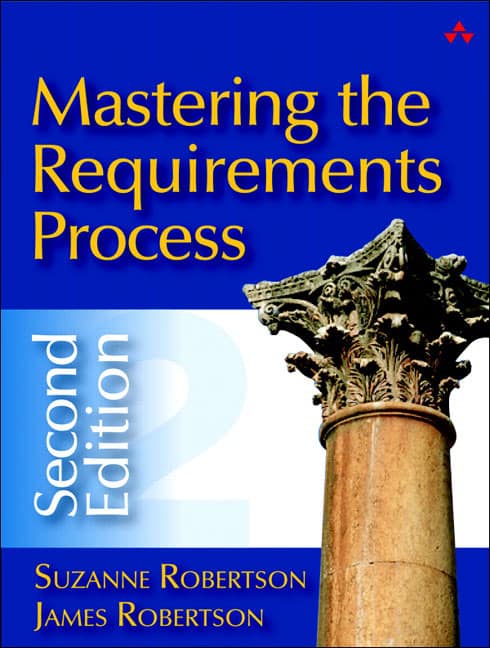
Published by: Addison-Wesley Professional
http://www.addison-wesley.de/main/main.asp?page=englisch/bookdetails&productid=116859
ISBN-13:978-0321419491
Publication date: 2006
Abstract: “If the purpose is to create one of the best books on requirements yet written, the authors have succeeded.”-Capers Jones. It is widely recognized that incorrect requirements account for up to 60 percent of errors in software products, and yet the majority of software development organizations do not have a formal requirements process. Many organizations appear willing to spend huge amounts on fixing and altering poorly specified software, but seem unwilling to invest a much smaller amount to get the requirements right in the first place. Mastering the Requirements Process, Second Edition, sets out an industry-proven process for gathering and verifying requirements with an eye toward today’s agile development environments. In this total update of the bestselling guide, the authors show how to discover precisely what the customer wants and needs while doing the minimum requirements work according to the project’s level of agility. Features include The Volere requirements process-completely specified, and revised for compatibility with agile environments A specification template that can be used as the basis for your own requirements specifications New agility ratings that help you funnel your efforts into only the requirements work needed for your particular development environment and project How to make requirements testable using fit criteria Iterative requirements gathering leading to faster delivery to the client Checklists to help identify stakeholders, users, nonfunctional requirements, and more Details on gathering and implementing requirements for iterative releases An expanded project sociology section for help with identifying and communicating with stakeholders Strategies for exploiting use cases to determine the best product to build Methods for reusing requirements and requirements patterns Examples showing how the techniques and templates are applied in real-world situations.
Writing Better Requirements
Ian F. Alexander, Richard Stevens
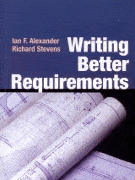
Published by: Addison-Wesley
ISBN-13: 9 780321 131638
Publication date: 2002
Paperback
Abstract
This book specifically focuses on how to discover and express requirements. It is not about system specification, nor how to make a design that meets user needs, nor even about how users should ensure their requirements are met.Since users own the requirements, these must be expressed in a way users can understand. This book treats requirements as simple pieces of text, supported by operational scenarios and informal diagrams. Many attempts have been made to improve on these simple means, using more formal structures and notations with varying success. We have not tried to cover all these approaches.
To place requirements in context,the book must of course cover some aspects of the development process. Project management, verification, quality assurance, and the development life cycle are all closely linked with requirements n indeed each of these areas is meaningless in isolation. But in this book, we concentrate on the tasks of capturing and writing requirements. Each chapter contains exercises to help readers to practice their skills.
We recommend some good books for readers who want to go beyond writing good requirements to other aspects of systems and requirements engineering.
Discovering Requirements – How to Specify Products and Services
Ian Alexander, Ljerka Beus-Dukic
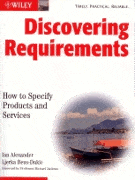
Published by: Wiley
http://au.wiley.com/WileyCDA/Section/index.html
ISBN-13: 978-0-470-71240-5
Publication date: 2009
Paperback
Description: This easy to read guide is full of carefully-checked tips and tricks. Illustrated with worked examples, checklists, summaries, keywords and exercises, this book will encourage you to move closer to the real problems you’re trying to solve. Guest boxes from other experts give you additional hints for your projects.
Invaluable for anyone specifying requirements including IT practitioners, engineers, developers, business analysts, test engineers, configuration managers, quality engineers and project managers. A practical sourcebook for lecturers as well as students studying software engineering who want to learn about requirements work in industry.
Once you’ve read this book you will be ready to create good requirements!
Conferences and Meetings
3rd IEEE Track on Collaborative Modeling and Simulation (COMETS 2012)
June 25-27, 2012, Toulouse, France
More information http://www.sel.uniroma2.it/comets12
Human Factors and Ergonomics Society (HFES) 2012 Annual Meeting
October 22-26, 2012, Boston, Massachusetts USA
More information https://www.hfes.org//Web/HFESMeetings/meetings.html|
Sixth IEEE International Conference on Self-Adaptive and Self-Organizing Systems (SASO 2012)
10-14 September 2012, Lyon, France
More information http://saso2012.univ-lyon1.fr/
International Conference on Business Process Modeling, Development, and Support (BPMDS 2012), the 13th edition of the BPMDS series, held in Conjunction with Conference on Advanced Information Systems Engineering (CAiSE’12)
25-26 June 2012, Gdansk, Poland
More information http://bpmds.org/
Right Requirements, Right Now: Strategies for Successful Software Projects International Institute of Business Analysis [IIBA] Los Angeles
Feb 21, 2012, 6:00pm – 9:00pm, Los Angeles (USA)
More information http://losangeles.iiba.org/
3rd IEEE Track on Collaborative Modeling & Simulation (CoMetS’12) in WETICE 2012 21st IEEE International Conference on Collaboration Technologies and Infrastructures (WETICE is an annual IEEE International conference on state-of-the-art research in enabling technologies for collaboration, consisting of a number of cognate conference tracks)
June 25 – 27, 2012, Toulouse (France)
More information http://www.sel.uniroma2.it/comets12/
18th International Symposium on Formal Methods
August 27 – 31, 2012, CNAM, Paris, France
More information http://fm2012.cnam.fr
CMMI Made Practical 2012
April 26 – 27, 2012 London, UK
More information http://www.cmminews.com/2012/
10th International Conference on Formal Modeling and Analysis of Timed Systems (FORMATS 2012)
September 18-20, 2012, London, United Kingdom
More information http://go.warwick.ac.uk/formats2012/
The Third International Symposium on Engineering Systems – CESUN 2012
June 18 – 20, 2012, Delft, The Netherlands
More information www.cesun2012.tudelft.nl
3rd International Conference on Complex Systems Design and Management
December 12-14, 2012, Paris, France
More information http://www.csdm2012.csdm.fr/
2012 Industrial and Systems Engineering Research Conference
May 19 – 23, 2012, Orlando, Florida
More information http://www.iienet.org/annual
IEEE SOSE 2012 7th International Conference on System of Systems Engineering
July 16 – 19, 2012, Genoa, Italy
More information http://www.sose2012.eu/
Willkommen zur REConf® 2012
March 12 – 16, 2012, Munich, Germany
More information www.reconf.de
2012 Workshop on Requirements Engineering – South America
April 24 – 27, 2012, Buenos Aires
More information: http://wer2012.unlam.edu.ar/
Education and Academia
Help for Individuals Selecting Engineering Schools and Programs
www.EngineeringDegreeGuides.org provides information concerning engineering schools, obtaining an engineering degree online, as well as degree programs, admissions requirements, tuition, and accreditation. According to the U.S. Bureau of Labor Statistics, engineering jobs across all specialties are expected to grow by 11 percent in the U.S. over the next six years. These statistics are not lost on recent high school and community college graduates who are increasingly looking for solid career paths. The same can be said for mid-career path individuals looking to advance their careers. The Web site is dedicated to providing useful resources that range from admissions requirements, degree programs, types of degrees, schools, tuition, to accreditation.
NASA Graduate Certificate in Space System Engineering
The National Aeronautics and Space Administration (NASA) (USA) intends to issue a sole source contract to Stevens Institute of Technology School of Systems & Enterprises/Castle Point on Hudson, Hoboken, NJ 07030 for a training program entitled “Graduate Certificate in Space System Engineering.” The objective of the program is to provide a project management leadership curriculum for Johnson Space Center (JSC) employees selected for the Space Systems Engineering Development Program. The contractor shall provide a Graduate Certificate Program in Space Systems Engineering for 26 participants in SSEDP.
More Information http://www.spaceref.com/news/viewsr.html?pid=39685
Research Fellow and Post-doctorate Positions Available
Financial Services Governance, Risk and Compliances Competence Centre (GRC3), University College Cork, Ireland
The following positions will be of interest to researchers in the systems and software engineering community as they require relevant research expertise:
1. Research Fellow in Ontology and Business Process Modeling,
2. Research Fellow in Capability Maturity Modeling,
3. Post-Doctorate Researcher in Business Process and Data Modeling,
4. Post Doctorate Researcher in Capability Maturity and Business
Process Modeling,
5. Post-Doctorate Researcher in Data and Business Process Modeling
More Information: http://www.ucc.ie/en/hr/vacancies/research/
Point of Contact: tbutler (at) afis.ucc.ie
If emailing, please insert the position title in the email subject heading as follows:
GRC3 Research Fellow or GRC3 Post-doctorate position.
Position Available at INRIA Sophia Antipolis, France
EPI Aoste, from INRIA Sophia Antipolis-Méditerranée Research Center in the south-east of France, is offering a one-year position in the fields of model-driven engineering and embedded systems. The position is for a Research Associate (Post-doc) holding a PhD in computer science, computer engineering or software engineering.
More Information Send a CV to Frederic.Mallet@inria.fr
New Student Group Opens Doors to Careers in Systems Engineering
Arizona State University students can delve into the field beyond their classroom studies through a student division of the International Council on Systems Engineering (INCOSE).
“We connect students with the systems engineering resources available outside of the university,” says Eric Luster, INCOSE at ASU president and doctoral student in the computer science program in the School of Computing, Informatics and Decision Systems Engineering.
Luster helped in the effort to establish the group in December 2010. The group offers students opportunities to network with system engineering professionals and get hands-on experience.
More Information https://asunews.asu.edu/20120126_incoseatasu
Texas A&M University Faculty Position at Full Professor Level
The Industrial & Systems Engineering Department at Texas A&M has an open position for a faculty member at the full professor level. The area of interest is systems engineering, and TAMU is considering a broad definition of this area which includes those with expertise in cognitive systems.
More information: Thomas Ferris, Ph.D., Assistant Professor, Industrial and Systems Engineering, Texas A&M University
Phone: 979-458-2340. email: tferris (at) tamu.edu
http://ise.tamu.edu/People/faculty/Ferris
Some Systems Engineering-Relevant Websites
This is the website of the 2012 CMMI Made Practical conference to be held in London over 26-27 April, 2012. The site is mentioned here for its archive of downloadable presentations for previous years’ conferences – a treasure trove of practical information and experiences in implementing and using CMMI. CMMI (Capability Maturity Model Integration) is a systems and software process improvement approach whose goal is to help organizations improve their performance.
http://www.sei.cmu.edu/cmmi/solutions/info-center.cfm
This is the home page for the Carnegie Mellon University, Pittsburgh, USA’s Software Engineering Institute Capability Maturity Model Integration (CMMI). The site contains comprehensive information about this very significant systems and software process reference model.
http://www.computer.org/sevocab
Find authoritative definitions for software and systems engineering terms in SEVOCAB.
A project of the IEEE Computer Society and ISO/IEC JTC 1/SC7, SEVOCAB includes definitions from international standards. One can search for a term as defined in the standards, or for all the definitions in a source standard. To provide an understanding of related concepts, SEVOCAB will return any definition for the term, as well as all the definitions that use the term. Over 300 terms and definitions from recently published standards will be added to the vocabulary by mid 2012.
http://jbconsultinginternational.com/default.aspx
This is the website of JB Consulting International (JBCI), aka James W. Bilbro. The site contains some excellent material on technology maturity, Technology Readiness Levels (TRLs), Software Readiness Levels (SRLs), Advancement Degree of Difficulty (AD2) and system maturity.
http://graffletopia.com/stencils/849
This webpage contains OmniGraffle stencils for SysML diagram elements. The Systems Modeling Language (SysML) is a general-purpose modeling language for systems engineering applications. OmniGraffle is a drawing application for mac which allows graphics to be quickly created by keeping lines connected to shapes even when they’re moved, providing powerful styling tools, and importing and exporting Microsoft Visio files.
http://thaisysml.blogspot.com.au/2012/02/common-misunderstanding-in-using.html
This webpage addresses the question regarding SysML of why a connector cannot be used to connect between ports on the boundaries of blocks in BDD (SysML Block Definition Diagram).
Standards and Guides
EN 50126 / IEC 62278 Railway RAMS Standard
EN 50126-1 / IEC 62278 is a railway reliability/availability/maintainability (RAMS) standard published by CENELEC – the European Committee for Electrotechnical Standardization. There is a companion guide: CLC/TR 50126-2:2007 titled “Railway applications – The specification and demonstration of Reliability, Availability, Maintainability and Safety (RAMS) – Part 2: Guide to the application of EN 50126-1 for safety”.
More information:
The standard: http://www.cenelec.eu/dyn/www/f?p=104:110:4000723459736525::::FSP_PROJECT,FSP_LANG_ID:21752,25
The guide: http://www.cenelec.eu/dyn/www/f?p=104:110:3527193767937636::::FSP_PROJECT,FSP_LANG_ID:15359,25
A blog about issues and interpretations of the standard: http://en50126.blogspot.com/
Definitions to Close on
Unified Processes
Unified Process: The Unified Process is a popular iterative and incremental software development process framework. The best-known and extensively documented refinement of the Unified Process is the Rational Unified Process (RUP). The name Unified Process as opposed to Rational Unified Process is generally used to describe the generic process, including those elements which are common to most refinements.
Source: http://en.wikipedia.org/wiki/Unified_Process
Agile Unified Process (AUP): The Agile Unified Process (AUP) is a simplified version of the Rational Unified Process (RUP).
Source: http://www.ambysoft.com/unifiedprocess/agileUP.html
Enterprise Unified Process (EUP): The Enterprise Unified Process™ (EUP) is an extension to the RUP. The extensions include two new phases, Production and Retirement, and several new disciplines: Operations and Support and the seven enterprise disciplines:
• Enterprise Business Modeling
• Portfolio Management
• Enterprise Architecture
• Strategic Reuse
• People Management
• Enterprise Administration
• Software Process Improvement.
Source: http://www.enterpriseunifiedprocess.com/
Essential Unified Process for software development (EssUP): The Essential Unified Process for software development, or EssUP, was invented by Ivar Jacobson, intended to be an improvement on the Rational Unified Process. It identifies practices such as use cases, iterative development, architecture driven development, team practices and process practices, which are borrowed from RUP, CMMI and agile development. The concept of EssUP is that you pick those practices that are applicable to the situation and combine them into a process. This is considered an improvement with respect to RUP, because with RUP the practices are intertwined and cannot be taken in isolation. EssUP is supported by a set of playing cards, each card describing a practice.
Source: http://en.wikipedia.org/wiki/Essential_Unified_Process
Open Unified Process (OpenUP): The Open Unified Process (OpenUP) is a part of the Eclipse Process Framework (EPF), an open source process framework developed within the Eclipse Foundation. Its goals are to make it easy to adopt the core of the RUP / Unified Process.
Source: http://en.wikipedia.org/wiki/OpenUP
Rational Unified Process (RUP): The Rational Unified Process (RUP) is an iterative software development process framework created by the Rational Software Corporation, now a division of IBM. RUP is intended to be an adaptable process framework, intended to be tailored by the development organizations and software project teams that will select the elements of the process that are appropriate for their needs. RUP has, as its major features:
• Develop iteratively, with risk as the primary iteration driver
• Manage requirements
• Employ a component-based architecture
• Model software visually
• Continuously verify quality
• Control changes.
Source: http://en.wikipedia.org/wiki/IBM_Rational_Unified_Process
PPI News (see www.ppi-int.com)
PPI at the Singapore Air Show
PPI is proud to be exhibiting, under the Team Australia pavilion, at the upcoming Singapore Airshow 2012. This event, to take place nearby to Changi Airport. This show is expected to be even bigger than the last 2010 event which attracted 430459 trade attendees from 133 countries, 259 foreign government and international delegations, and 846 media personnel covering the event. To our Singaporean friends, feel free to stop by and visit our booth!
News Title
Content: Use SyEN Body Text for news information
PPI Events (see www.ppi-int.com)
Systems Engineering Public 5-Day Courses (Keep these as-is, Elise/Steph will update this information)
Upcoming Locations Include:
London, UK
Stellenbosch, South Africa
Las Vegas, USA
São José dos Campos, Brazil
Singapore
Requirements Analysis and Specification Writing Public Courses
Upcoming Locations Include:
Fremantle, WA Australia
Melbourne, Australia
Amsterdam, The Netherlands
Software Engineering Public 5-Day Courses
Upcoming Locations Include:
Sydney, Australia
Pretoria, South Africa
Amsterdam, The Netherlands
OCD/CONOPS Public Courses
Upcoming Locations Include:
Pretoria, South Africa
Las Vegas, USA
Brasilia, Brazil
Cognitive Systems Engineering Courses
Upcoming Locations Include:
Adelaide, Australia
Las Vegas, USA
PPI Upcoming Participation in Professional Conferences (Steph/Elise can update this information)
PPI will be participating in the following upcoming events. We look forward to chatting with you there.
INCOSE LA Mini-Conference | Las Angeles, CA, USA (31 March)
Singapore Airshow | Exhibiting | (14-19 February 2012)
SETE/APCOSE 2012 | Exhibiting | Brisbane ( 30 April – 2 May 2012)
INCOSE IS 2012 | Exhibiting | Rome, Italy (9 – 12 July, 2012)
Kind regards from the SyEN team:
Robert Halligan, Managing Editor, email: rhalligan@ppi-int.com
Ralph Young, Editor, email: ryoung@ppi-int.com
Stephanie Halligan, Production, email: shalligan@ppi-int.com
Project Performance International
2 Parkgate Drive, Ringwood, Vic 3134 Australia
Tel: +61 3 9876 7345
Fax: +61 3 9876 2664
Tel Brasil: +55 11 3230 8256
Tel UK: +44 20 3286 1995
Tel USA: +1 888 772 5174
Email: contact@ppi-int.com
Copyright 2012 Project Performance (Australia) Pty Ltd, trading as Project Performance International
Tell us what you think of SyEN: email to contact@ppi-int.com
If you do not wish to receive a copy monthly of SyEN in future, please reply to this e-mail with “Remove” in the subject line. All removals are acknowledged; you may wish to contact PPI if acknowledgement is not received within 7 days.



